CITY×PEOPLE×DESIGN
01 January 2012
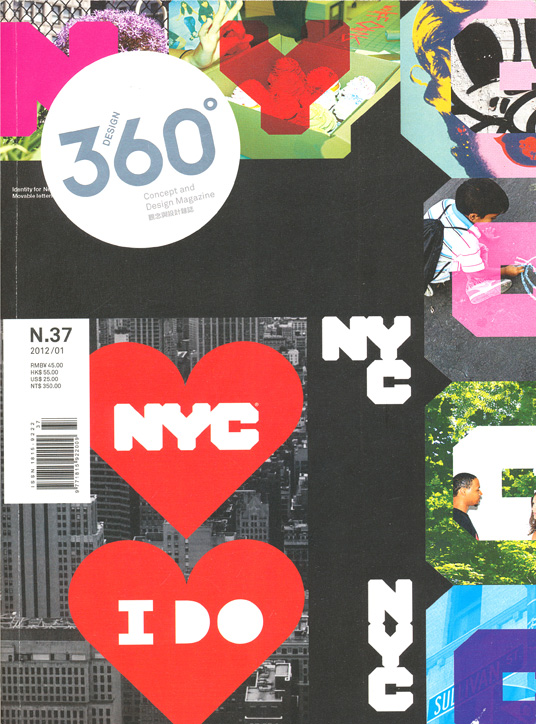
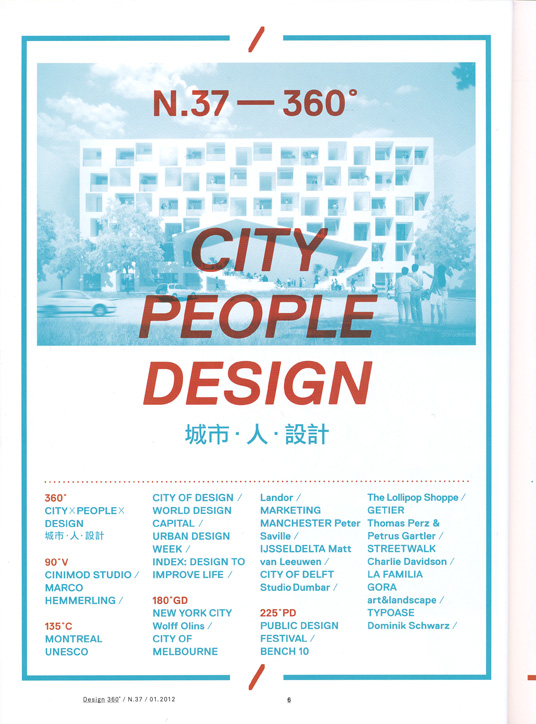
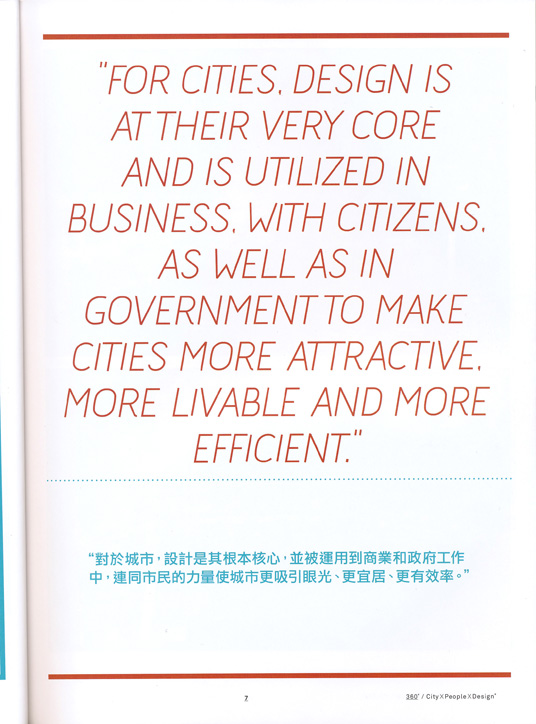
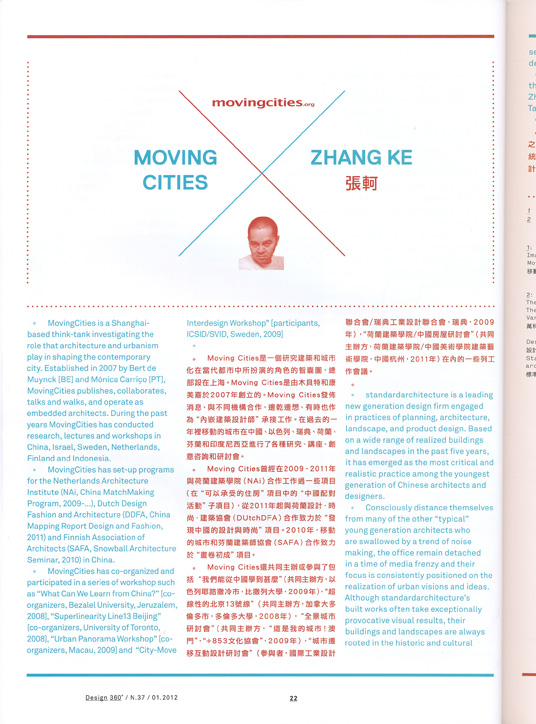
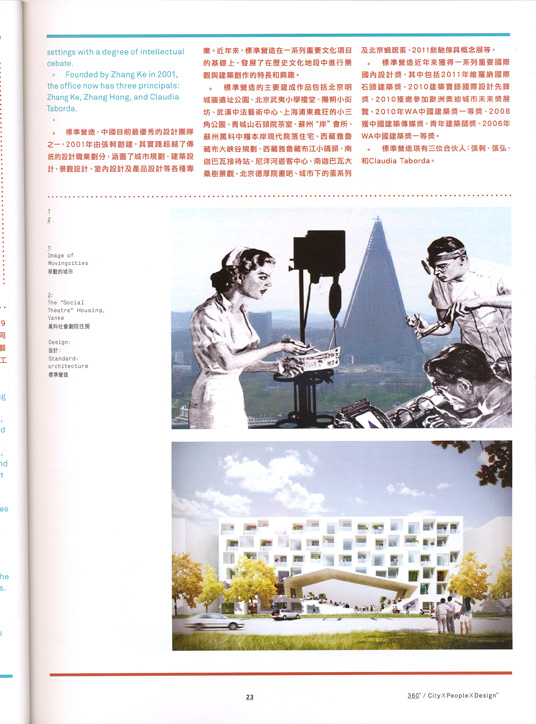
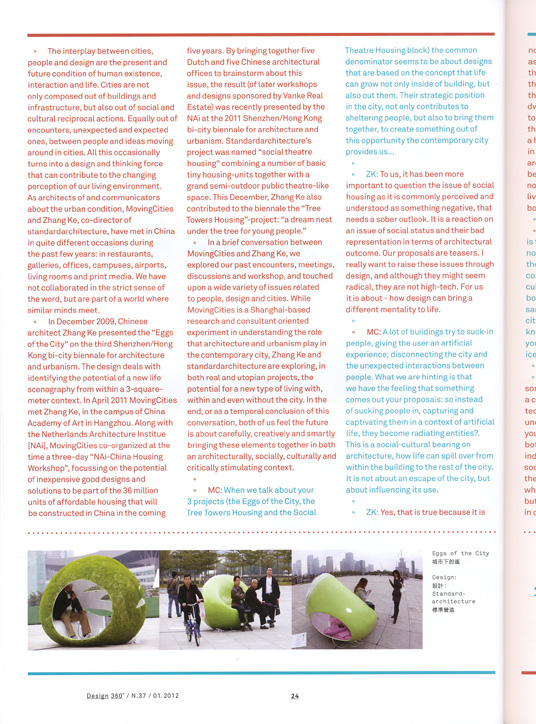
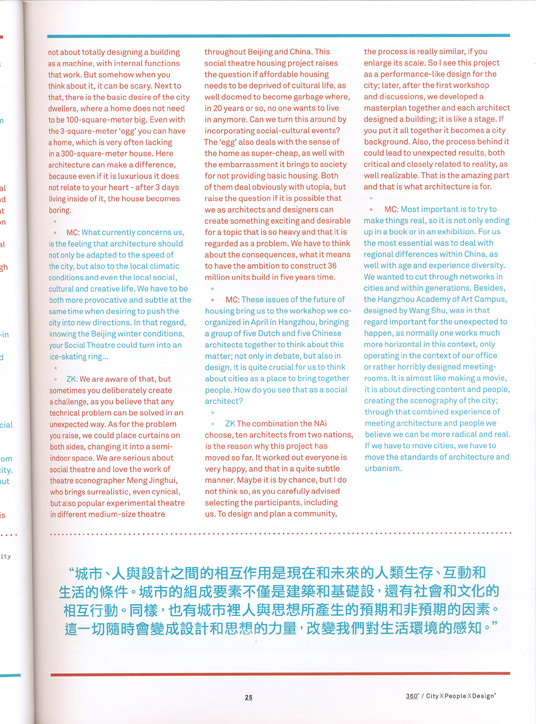
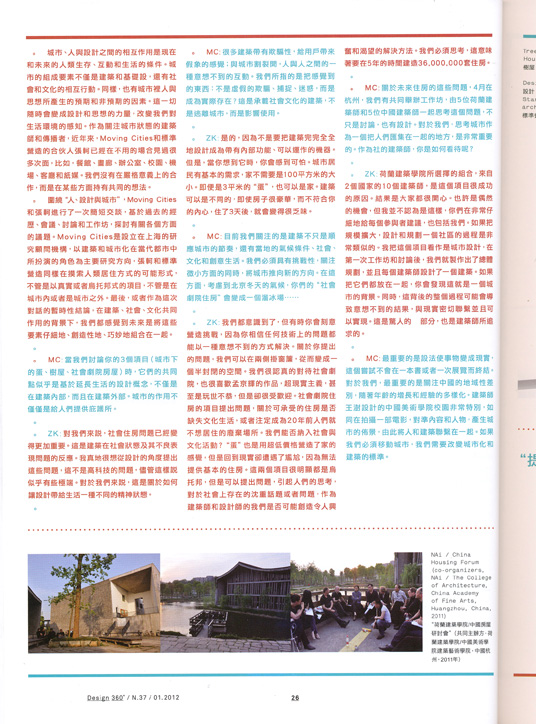
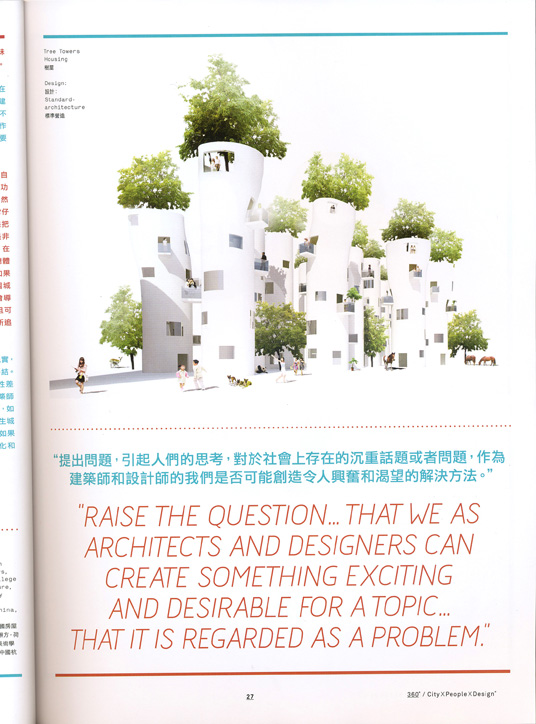
MovingCities is a Shanghai-based think-tank investigating the role that architecture and urbanism play in shaping the contemporary city. Established in 2007 by Bert de Muynck [BE] and Mónica Carriço [PT], MovingCities publishes, collaborates, talks and walks, and operate as embedded architects. During the past years MovingCities has conducted research, lectures and workshops in China, Israel, Sweden, Netherlands, Finland and Indonesia.
MovingCities has set-up programs for the Netherlands Architecture Institute (NAi, China MatchMaking Program, 2009-...), Dutch Design Fashion and Architecture (DDFA, China Mapping Report Design and Fashion, 2011) and Finnish Association of Architects (SAFA, Snowball Architecture Seminar, 2010) in China.
MovingCities has co-organized and participated in a series of workshop such as "What Can We Learn from China?" [co-organizers, Bezalel University, Jeruzalem, 2008], "Superlinearity Line13 Beijing" [co-organizers, University of Toronto, 2008], "Urban Panorama Workshop" [co-organizers, Macau, 2009] and "City-Move Interdesign Workshop" [participants, ICSID/SVID, Sweden, 2009]
standardarchitecture is a leading new generation design firm engaged in practices of planning, architecture, landscape, and product design. Based on a wide range of realized buildings and landscapes in the past five years, it has emerged as the most critical and realistic practice among the youngest generation of Chinese architects and designers.
Consciously distance themselves, from many of the other "typical" young generation architects who are swallowed by a trend of noise making, the office remain detached in a time of media frenzy and their focus is consistently positioned on the realization of urban visions and ideas. Although standardarchitecture's built works often take exceptionally provocative visual results,their buildings and landscapes are always rooted in the historic and cultural settings with a degree of intellectual debate.
Founded by Zhang Ke in 2001, the office now has three principals: Zhang Ke, Zhang Hong, and Claudia Taborda.
The interplay between cities, people and design are the present and future condition of human existence, interaction and life. Cities are not only composed out of buildings and infrastructure, but also out of social and cultural reciprocal actions. Equally out of encounters, unexpected and expected ones, between people and ideas moving around in cities. All this occasionally turns into a design and thinking force that can contribute to the changing perception of our living environment. As architects of and communicators about the urban condition, MovingCities and Zhang Ke, co-director of standardarchitecture, have met in China in quite different occasions during the past few years: in restaurants, galleries, offices, campuses, airports, living rooms and print media. We have not collaborated in the strict sense of the word, but are part of a world where similar minds meet.
In December 2009, Chinese architect Zhang Ke presented the "Eggs of the City" on the third Shenzhen/Hong Kong bi-city biennale for architecture and urbanism. The design deals with identifying the potential of a new life scenography from within a 3-square-meter context. In April 2011 MovingCities met Zhang Ke, in the campus of China Academy of Art in Hangzhou. Along with the Netherlands Architecture Institue [NAi], MovingCities co-organized at the time a three-day "NAi-China Housing Workshop", focussing on the potential of inexpensive good designs and solutions to be part of the 36 million units of affordable housing that will be constructed in China in the coming five years. By bringing together five Dutch and five Chinese architectural offices to brainstorm about this issue, the result (of later workshops and designs sponsored by Vanke Real Estate) was recently presented by the NAi at the 2011 Shenzhen/Hong Kong bi-city biennale for architecture and urbanism. Standardarchitecture's project was named "social theatre housing" combining a number of basic tiny housing-units together with a grand semi-outdoor public theatre-like space. This December, Zhang Ke also contributed to the biennale the "Tree Towers Housing"-project: "a dream nest under the tree for young people."
In a brief conversation between MovingCities and Zhang Ke, we explored our past encounters, meetings, discussions and workshop, and touched upon a wide variety of issues related to people, design and cities. While MovingCities is a Shanghai-based research and consultant oriented experiment in understanding the role that architecture and urbanism play in the contemporary city, Zhang Ke and standardarchitecture are exploring, in both real and utopian projects, the potential for a new type of living with, within and even without the city. In the end, or as a temporal conclusion of this conversation, both of us feel the future is about carefully, creatively and smartly bringing these elements together in both an architecturally, socially, culturally and critically stimulating context.
MC: When we talk about your 3 projects (the Eggs of the City, the Tree Towers Housing and the Social Theatre Housing block) the common denominator seems to be about designs that are based on the concept that life can grow not only inside of building, but also out them. Their strategic position in the city, not only contributes to sheltering people, but also to bring them together, to create something out of this opportunity the contemporary city provides us...
ZK: To us, it has been more important to question the issue of social housing as it is commonly perceived and understood as something negative, that needs a sober outlook. It is a reaction on an issue of social status and their bad representation in terms of architectural outcome. Our proposals are teasers, I really want to raise these issues through design, and although they might seem radical, they are not high-tech. For us it is about- how design can bring a different mentality to life.
MC: A lot of buildings try to suck-in people, giving the user an artificial experience; disconnecting the city and the unexpected interactions between people. What we are hinting is that we have the feeling that something comes out your proposals: so instead of sucking people in, capturing and captivating them in a context of artificial life, they become radiating entities?.
This is a social-cultural bearing on architecture, how life can spill over from within the building to the rest of the city. It is not about an escape of the city, but about influencing its use.
ZK: Yes, that is true because it is not about totally designing a building as a machine, with internal functions that work. But somehow when you think about it, it can be scary. Next to that, there is the basic desire of the city dwellers, where a home does not need to be 100-square-meter big. Even with the 3-square-meter 'egg' you can have a home, which is very often lacking in a 300-square-meter house. Here architecture can make a difference, because even if it is luxurious it does not relate to your heart -after 3 days living inside of it, the house becomes boring.
MC: What currently concerns us, is the feeling that architecture should not only be adapted to the speed of the city, but also to the local climatic conditions and even the local social, cultural and creative life. We have to be both more provocative and subtle at the same time when desiring to push the city into new directions. In that regard, knowing the Beijing winter conditions, your Social Theatre could turn into an ice-skating ring...
ZK: We are aware of that, but sometimes you deliberately create a challenge, as you believe that any technical problem can be solved in an unexpected way. As for the problem you raise, we could place curtains on both sides, changing it into a semi-indoor space. We are serious about social theatre and love the work of theatre scenographer Meng Jinghui, who brings surrealistic, even cynical, but also popular experimental theatre in different medium-size theatre throughout Beijing and China. This social theatre housing project raises the question if affordable housing needs to be deprived of cultural life, as well doomed to become garbage where, in 20 years or so, no one wants to live in anymore. Can we turn this around by incorporating social-cultural events? The 'egg' also deals with the sense of the home as super-cheap, as well with the embarrassment it brings to society for not providing basic housing. Both of them deal obviously with utopia, but raise the question if it is possible that we as architects and designers can create something exciting and desirable for a topic that is so heavy and that it is regarded as a problem. We have to think about the consequences, what it means to have the ambition to construct 36 million units build in five years time.
MC: These issues of the future of housing bring us to the workshop we co-organized in April in Hangzhou, bringing a group of five Dutch and five Chinese architects together to think about this matter; not only in debate, but also in design. It is quite crucial for us to think about cities as a place to bring together people. How do you see that as a social architect?
ZK: The combination the NAi choose, ten architects from two nations, is the reason why this project has moved so far. It worked out everyone is very happy, and that in a quite subtle manner. Maybe it is by chance, but I do not think so, as you carefully advised selecting the participants, including us. To design and plan a community, the process is really similar, if you enlarge its scale. So I see this project as a performance-like design for the city; later, after the first workshop and discussions, we developed a masterplan together and each architect designed a building; it is like a stage. If you put it all together it becomes a city background. Also, the process behind it could lead to unexpected results, both critical and closely related to reality, as well realizable. That is the amazing part and that is what architecture is for.
MC: Most important is to try to make things real, so it is not only ending up in a book or in an exhibition. For us the most essential was to deal with regional differences within China, as well with age and experience diversity. We wanted to cut through networks in cities and within generations. Besides, the Hangzhou Academy of Art Campus, designed by Wang Shu, was in that regard important for the unexpected to happen, as normally one works much more horizontal in this context, only operating in the context of our office or rather horribly designed meeting-rooms. It is almost like making a movie, it is about directing content and people, creating the scenography of the city; through that combined experience of meeting architecture and people we believe we can be more radical and real. If we have to move cities, we have to move the standards of architecture and urbanism.
城市·人·设计
Moving Cities是一个研究建筑和城市化在当代都市中所扮演的角色的智囊团,总部设在上海。Moving Cities是由木贝特和康美嘉于2007年创立的。Moving Cities发布消息、与不同机构合作、边干边想、有时也作为“内嵌建筑设计师”承接工作。在过去的一年里移动的城市在中国、以色列、瑞典、荷兰、芬兰和印度尼西亚进行了各种研究、讲座、创意咨询和研讨会。
Moving Cities曾经在2009-2011年与荷兰建筑学院(NAi)合作工作过一些项目(在“可以承受的住房”项目中的“中国配对活动”子项目),从2011年起与荷兰设计·时尚·建筑协会(DUtchDFA)合作致力于“发现中国的设计与时尚”项目。2010年,移动的城市和芬兰建筑师协会(SAFA)合作致力于“书卷初成”项目。
Moving Cities还共同主办或参与了包括“我们能从中国学到甚么”(公共主办方,以色列耶路撒冷市,比撒列大学,2009年),“超线性的北京13号线”(共同主办方,加拿大多伦多市,多伦多大学,2008年),“全景城市研讨会”(共同主办方,“这是我的城市!澳门”,“+853文化协会”,2009年),“城市迁移互动设计研讨会”(参与者,国际工业设计联合会/瑞典工业设计联合会,瑞典,2009年),“荷兰建筑学院/中国房屋研讨会”(共同主办方,荷兰建筑学院/中国美术学院建筑艺术学院,中国杭州,2011年)在内的一些列工作会议。
标准营造,中国目前最优秀的设计团队之一,2001年由张轲创建,其实践超越了传统的设计职业划分,涵盖了城市规划、建筑设计、景观设计、室内设计及产品设计等各种专业。近年来,标准营造在一系列重要文化项目的基础上,发展了在历史文化地段中进行景观与建筑创作的特长和兴趣。
标准营造的主要建成作品包括北京明城墙遗址公园、北京武夷小学礼堂、阳朔小街坊、武汉中法艺术中心、上海浦东疯狂的小三角公园、青城山石头院茶室、苏州“岸”会所、苏州万科中粮本岸现代院落住宅、西藏雅鲁藏布大峡谷规划、西藏雅鲁藏布江小码头、南迦巴瓦接待站、尼洋河游客中心、南迦巴瓦大桑树景观、北京德厚院书吧、城市下的蛋系列及北京蜗居蛋、2011锐驰家具概念展等。
标准营造近年来获得一系列重要国际国内设计奖,其中包括2O11年维罗纳国际石头建筑奖、2O1O建筑实录国际设计先锋奖、2O1O获邀参加欧洲奥迪城市未来奖展览、2O1O年WA中国建筑奖一等奖、2008获中国建筑传媒奖,青年建筑师奖、2006年WA中国建筑奖一等奖。
标准营造现有三位合伙人:张轲、张弘、和Claudia Taborda。
城市、人与设计之间的相互作用是现在和未来的人类生存、互动和生活的条件。城市的组成要素不仅是建筑和基础设,还有社会和文化的相互行动。同样,也有城市里人与思想所产生的预期和非预期的因素。这一切随时会变成设计和思想的力量,改变我们对生活环境的感知。作为关注城市状态的建筑师和传播者,近年来,Moving Cities和标准营造的合伙人张轲已经在不用的场合见过很多次面,比如,餐馆、书廊、办公室、校园、机场、客厅和纸媒。我们没有在严格意义上的合作,而是在某些方面持有共同的想法。
围绕“人、设计与城市”,Moving Cities和张轲进行了一次简短交谈,基于过去的经历、会议、讨论和工作坊,探讨有关各个方面的议题。Moving Cities 是设立在上海的研究顾问机构,以建筑和城市化在当代都市中所扮演的角色为主要研究方向,张轲和标准营造同样在摸索人类居住方式的可能形式,不管是以真实或者乌托邦式的项目,不管是在城市内或者是城市之外。最后,或者作为这次对话的暂时性结论,在建筑、社会、文化共同作用的背景下,我们都感觉到未来是将这些要素仔细地、创造性地、巧妙地组合在一起。
MC:当我们讨论你的3个项目(城市下的蛋、树屋、社会剧院房屋)时,它们的共同点似乎是基于延长生活的设计概念,不仅是在建筑内部,而且在建筑外部。城市的作用不仅仅是给人们提供庇护所。
ZK∶对我们来就,社会住房问题已经变得更加重要。这是建筑在社会状态及其不良表现问题的反应。我真地很想从设计的角度提出这些问题,这不是高科技的问题,尽管这样说似乎有些极端。对于我们来说,这是关于如何请设计带给生活一种不同的精神状态。
MC:很多建筑带有欺骗性,给用户带来假象的感觉;与城市裂开,人与人之间的一种意想不到的互动。我们所指的是把感觉到的东西:不是虚假的欺骗、捕捉、迷惑,而是成为实际存在?这是承载社会文化的建筑,不是逃离城市,而是影响使用。
ZK:是的,因为不是要把建筑完完全全地设计成为带有内部功能、可以运作的机器。但是,当你想到它时,你会感到可怕。城市居民有基本的需求,家不需要是100平方米的大小。即便是3平米的“蛋”,也可以是家。建筑可以是不同的,即使房子很豪华,而不符合你的内心,住了3天后,就会变得很乏味。
MC∶目前我们关注的是建筑不只是顺应城市的节奏,还有当地的气候条件、社会、文化和创意生活。我们必须具有挑战性,关注微小方面的同时,将城市推向新的方向。在这方面,考虑到北京冬天的气候,你们的“社会剧院住房”会变成一个溜冰埸……
ZK:我们都意识到了,但有时你会刻意营造挑战,因为你相信任何技术上的问题都能以一种意想不到的方式解决。关于你提出的问题,我们可以在两侧掛窗廉,从而变成一个半封闭的空间。我们很认真的对待社会剧院,也很喜欢孟京辉的作品,超现实主义,甚至是玩世不恭,但是卻很受欢迎。社会剧院住房的项目提出问题,关于可承受的住房是否缺失文化生活,或者注定成为20年前人们就不想居住的废弃场所。我们能否纳入社会与文化活动?“蛋”也是用超低价格营造了家的感觉,但是回到现实卻邻遭遇了尴尬,因为无法提供基本的住房。这两个项目很明显都是乌托邦,但是可以提出问题,引起人们的思考,对于杜会上存在的沈重话题或者问题,作为建筑师和设计师的我们是否可能创造令人兴奋和渴望的解决方法。我们必须思考,这意味着要在5年的时间建造36,000,000套住房。
MC:关于未来住房的这些问题,4月在杭州,我们有共同举办工作坊,由5位荷兰建筑师和5位中国建筑师一起思考这个问题,不只是讨论,也有设计。对于我们,思考城市作为一个把人们汇集在一起的地方,是非常重要的。作为社的建筑师,你是如何看待呢?
ZK:荷兰建筑学院所选择的组合,来自2个国家的10个建筑师,是这个项目很成功的原因。结果是大家都很开心。也许是偶然的机会,但我并不认为是这样、,你们在非常仔细地给每个参与者建议,也包括我们。如果把规模扩大,设计和规划一个社区的过程是非常类似的。我把这个项目看作是城市设计,在第一次工作坊和讨论后,我们就制作出了总体规划,并且每个建筑师设计了一个建筑。如果把们都放在一起,你会发现这就是一个城市的背景。同时,这背后的整个过程可能会导致意想不到的结果,与现实密切联系并且可以实现。这是圣诞惊人的部分,也是建筑师所追求的。
MC:最重要的是设法使事物变成现实,这个尝试不会在一本书或者一次展览而终结。对于我们,最重要的是关注中国的地域性差别,随着年龄的增长和经验的多样化。建筑师王澍设计的中国美术学院校园非常特别,如同在拍摄一部电影,对准内容和人物,产生城市的布景,由此将人和建筑联系在一起。如果我们必须移动城市,我们需要改变城市化和建筑的标准。